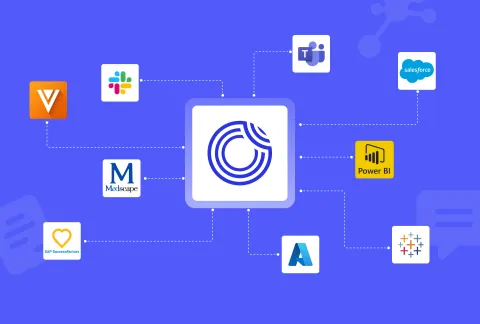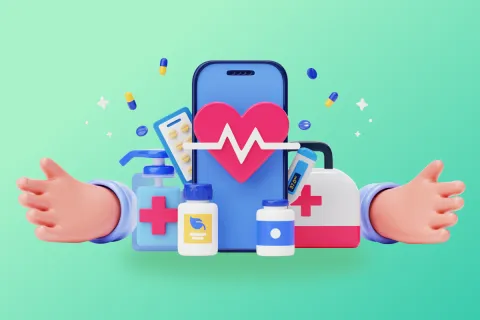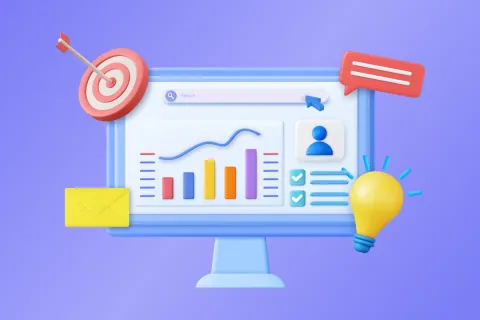In pharmaceutical and healthcare training, siloed systems create more than an inconvenience—they generate regulatory risks, drive up costs, and create blind spots that threaten compliance.
But imagine your LMS could talk seamlessly with your every other system. You could turn training from a compliance checkbox into a strategic business driver that enables performance across your entire organization, from internal teams to external partners and patients.
An LMS with API-first architecture can be the hub of a dynamic training ecosystem rather than just another isolated tool.
What you can do with an API-first LMS
With an API-first LMS like Opigno Enterprise, you decide which systems connect to your training platform and how data flows between them.
Let’s look at how this architecture solves common training challenges in complex, regulated environments like pharma and healthcare.
1. Authenticate users from the right source
With training audiences spread across internal teams, external partners, healthcare professionals, and even patients, managing access manually creates friction and errors.
An API-first LMS can:
- Connect to internal identity systems (e.g., LDAP, Active Directory, hospital directories) for secure, policy-driven employee access.
- Pull records from CRMs to onboard customers, distributors, or sales reps with role-specific access.
- Support OAuth or SAML authentication from external portals, reducing the need for duplicate credentials.
This approach reduces onboarding time, eliminates duplicate accounts, and streamlines compliance so that when a new physician partner joins your network or a pharmacy requires updated compliance training, the right content reaches them automatically in their portal.
2. Sync learning data with business systems
Isolated training data tells an incomplete story, but in an integrated environment, it drives real insight:
- Feed dashboards in BI tools with live training progress, completions, and assessment scores to link them with performance or compliance metrics.
- Sync with HRIS platforms to automatically update employee profiles with certifications, skill gaps, or new competencies.
- Push data to regulatory or accreditation systems, ensuring required records, such as CME completions or audit trails, are delivered automatically.
Opigno Enterprise LMS even allows custom endpoints to support your unique compliance and analytics workflows. So whether it’s reporting CME credits or analyzing regional product knowledge, data flows where needed without manual exports.
3. Deliver learning where it happens
Training isn’t confined to the LMS interface, but an API-first LMS helps keep different channels connected:
- Schedule live meetings and track attendance from the LMS via calendar or meeting platform integration.
- Share credentials and certifications with professional networks to amplify your training impact.
- Embed microlearning or onboarding flows in third-party apps, including mobile apps used by field reps, pharmacy partners, or patients.
In headless LMS setups like Opigno Enterprise, these integrations are especially powerful as you can integrate content directly into portals or intranets so that HCPs or distributors can access training where they already work without ever visiting the LMS.
For healthcare professionals juggling patient care and professional development, this flexibility isn’t just convenient—it’s critical to delivering the right knowledge at the right moment.
4. Automate compliance reporting
Compliance is often the most integration-intensive part of training—and one of the riskiest to handle manually. With an API-first LMS, you can:
- Automate documentation and reporting flows, pushing completion data and digital signatures to compliance systems as soon as training is done.
- Centralize tracking while allowing local delivery, which is critical for multinational operations managing different regulatory regimes.
- Give auditors secure, real-time access to dashboards or documentation on demand.
Instead of scrambling to compile proof of training during audits, reports can be generated automatically as part of your workflow and auto-sent to external authorities, region by region.
API-first isn’t just a tech upgrade—it’s a strategic shift
Adopting an API-first LMS isn’t only about connecting platforms—it’s about embedding training into the operational DNA of your organization.
For companies in life sciences and healthcare, where learning is tightly tied to compliance, global operations, and external engagement, this shift turns training into a scalable, measurable, and integrated business function.
And you don’t need to build the full ecosystem at once. Start with high-impact pain points—duplicate user management, siloed data, manual compliance workflows—and identify 1–2 integration opportunities where the return is immediate. Use your LMS’s API to connect those touchpoints with minimal disruption—then expand.
If you want to move fast and rely on a platform purpose-built for this approach, Opigno Enterprise provides the API-first, headless infrastructure—and the professional support—to make it work in your specific context. Let’s talk about building a connected learning ecosystem that reduces friction, scales with your organization, and stands up to regulatory demands.


